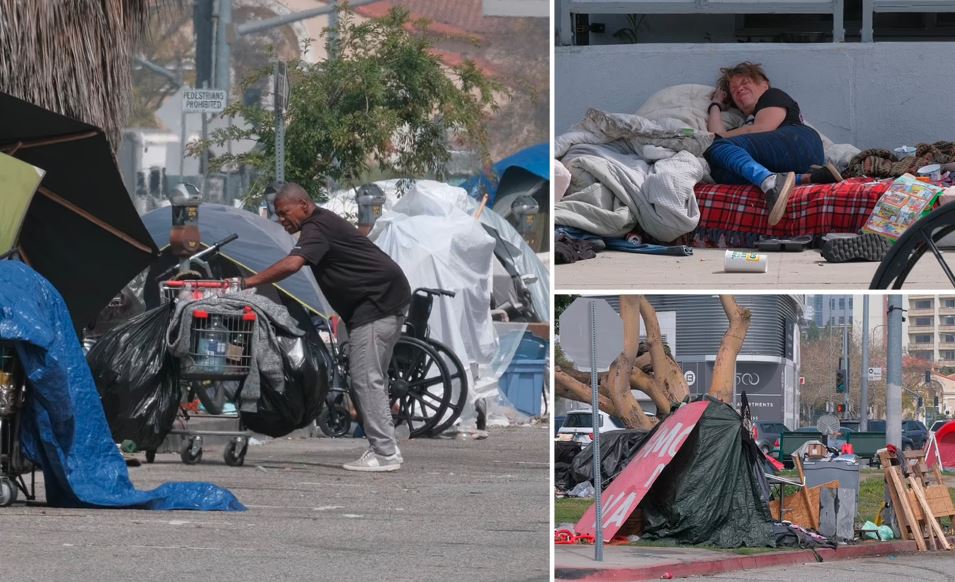Beverly Hills, the ground of Hollywood’s elite, is facing a growing concern as the homelessness crisis continues to worsen. Rising numbers of vagrant encampments made of tarpaulins, shopping carts, mattresses, and bedding are currently scattered, and Santa Monica Boulevard, which acts as a boundary between the Hills and the neighboring Beverly Grove, is heavily witnessing the effects.
Despite a median house price being a staggering $3.5 million in Beverly Hills, clusters of homeless encampments can be seen near intersections and sidewalks.

Recent photos paint a stark picture of the contrast between the opulent Beverly Hills and the growing presence of homeless encampments in its vicinity, with makeshift dwellings juxtaposed against the backdrop of high-end department stores and pristine green parklands. The scenes were documented along San Vicente Boulevard, which is located close to the upscale Beverly Center shopping mall.
San Vicente Boulevard is known to be frequented by celebrities such as Victoria Beckham, Paris Hilton, and Hailey Bieber for their shopping needs.

Approximately 40,000 individuals are estimated to be experiencing homelessness in the city of Los Angeles, which has a total population of nearly 4 million people. The Los Angeles Homeless Services Authority has reported that in 2022, there were around 70,000 individuals experiencing homelessness across Los Angeles County, marking a four percent increase compared to 2020.
In January, Sherman Oaks, an affluent neighborhood located north of Beverly Hills, gained national attention after three individuals died on its streets within a single week, bringing the issue of homelessness to the forefront.

While there are no precise statistics available for homelessness in Beverly Hills, a report from city manager Nancy Hunt-Coffey, as seen by the local publication Beverly Hills Courier, suggests the issue is seemingly on the rise. In 2022, several residents of Beverly Hills shared their testimonies with the city council, shedding light on their personal experiences with homelessness as part of a discussion aimed at addressing the escalating issue in the neighborhood.
‘Many of my peers are considering moving because they consider the situation hopeless,’ said Amy Conroy, who said she is scared to let her children play outside.

Los Angeles Mayor Karen Bass, recently elected, campaigned on promises to tackle the escalating homeless crisis. She tweeted about the Sherman Oaks deaths at the time, writing: ‘This is exactly why I’ve declared a state of emergency. Successfully confronting the homelessness crisis is a matter of life and death.’ The leading cause of death among individuals experiencing homelessness in Los Angeles is drug overdoses, including murder and suicide.
During a conference in January, Bass highlighted the attitudes of some affluent residents towards homelessness, stating they often prioritize the individuals elsewhere or resort to arrests, rather than addressing the root causes.

Mayor Bass then expressed her commitment to making significant strides, stating her intention to provide housing for over 17,000 homeless individuals in her first year in office. Between 2016 and 2021, fentanyl overdose deaths in Los Angeles County surged by more than tenfold. Specifically, from 2019 to 2020, there was a staggering increase of 149 percent, with the number of deaths rising from 462 to 1,149.
In 2021, there was a further 31 percent increase, reaching a total of 1,504 deaths.

Ken Craft, of the advocacy group Hope of the Valley, commented on the alarming homeless deaths in Sherman Oaks, telling ABC Los Angeles: ‘What we do see, unfortunately, is an increase in fentanyl on our streets, which has caused a higher level of overdoses.’ California Governor Gavin Newsom recently announced plans to reduce homelessness in the state by 15 percent within two years. As part of this initiative, the state has committed to providing 500 small homes in the city to help achieve this goal.
‘In California, we are using every tool in our toolbox – including the largest-ever deployment of small homes in the state – to move people out of encampments and into housing,’ Newsom said.

He added, “The crisis of homelessness will never be solved without first solving the crisis of housing; the two issues are inextricably linked.’ Los Angeles City Council member Joe Buscaino has also raised concerns, highlighting that some kids have to navigate through hazardous conditions, such as needles and human waste, as they go to school due to homeless individuals residing in residential areas.
‘No child in America should be afraid to walk to school, and what we have found in Los Angeles is kids are afraid to walk to school,” the Democrat Buscaino said in a television interview late last year.

He also added: “They tell their parents they have to step over needles, human waste, and deal with individuals, unfortunately, suffering from psychotic behavior, right next to their playground area.’ However, various initiatives have emerged to assist. One such initiative is CICRLE (Community Initiative for Comprehensive Resources for Living Environments), which operates in West Hollywood. They seek to address homelessness by providing pathways to stable housing for those living on the streets.


